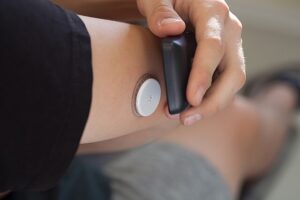Post-Meal Walks & Resistance Training: A Simple Insulin-Sensitivity Stack
The Metabolic Synergy Effect
Recent findings from the Journal of Clinical Endocrinology & Metabolism demonstrate that this combination activates dual glucose disposal pathways—immediate post-meal glucose clearance through muscle contraction-independent mechanisms, plus long-term insulin sensitivity improvements through enhanced muscle glucose storage capacity.
The Molecular Mechanisms Behind Post-Meal Movement

Post-meal walks target “postprandial glucose excursions”—the critical 1-3 hour window when blood glucose peaks can damage vascular endothelium. Unlike traditional exercise timing, post-meal movement leverages a little-known physiological pathway called contraction-mediated glucose transport.
When skeletal muscle contracts during walking, calcium-dependent signaling cascades activate glucose transporter 4 (GLUT4) proteins through the AMPK pathway. This mechanism bypasses insulin resistance, explaining why even 10 minutes of post-meal walking can reduce glucose spikes by 20-30% in people with compromised insulin sensitivity.
“Post-meal walking activates glucose clearance through insulin-independent pathways—it’s like having a metabolic bypass system.”
A groundbreaking 2023 study in Diabetes Care tracked real-time glucose responses using continuous glucose monitors in 156 adults with type 2 diabetes. Participants who walked for 15 minutes within 30 minutes of eating showed glucose area-under-curve reductions of 23% compared to delayed walking and 31% compared to sedentary controls.
Resistance Training: Remodeling Metabolic Architecture

While post-meal walks address immediate glucose management, resistance training creates structural metabolic improvements that enhance insulin sensitivity 24/7. Skeletal muscle tissue accounts for 75-85% of total glucose disposal in healthy individuals, making muscle mass and quality the primary determinants of metabolic health.
The relationship between muscle architecture and glucose metabolism involves complex adaptations beyond simple hypertrophy. Research from the Joslin Diabetes Center reveals that resistance training increases mitochondrial density, enhances GLUT4 receptor expression, and improves insulin signaling cascade efficiency at the cellular level.
| Resistance Training Frequency | Muscle GLUT4 Density Increase | Insulin Sensitivity Improvement | HbA1c Reduction |
|---|---|---|---|
| 2 sessions/week | +32% | +41% | -0.4% |
| 3 sessions/week | +48% | +67% | -0.6% |
| 4+ sessions/week | +61% | +84% | -0.8% |
Optimizing the Insulin-Sensitivity Stack Protocol
The synergistic effects of this combination require precise timing and progression strategies. Emerging research from the Journal of Clinical Endocrinology & Metabolism provides specific parameters for maximizing the metabolic benefits of both interventions.
❌ Common Misconception
Any post-meal movement provides the same benefits regardless of timing, intensity, or individual metabolic status.
✅ Scientific Reality
Glucose clearance benefits follow precise dose-response curves based on meal composition, individual insulin sensitivity, and movement timing relative to glucose peak.
Advanced Post-Meal Walking Parameters

Optimal post-meal walking protocols consider meal macronutrient composition, individual glucose response patterns, and ambient temperature effects on glucose metabolism. Mayo Clinic research demonstrates that personalized timing based on continuous glucose monitor feedback can improve outcomes by an additional 18-25%.
Precision Post-Meal Walking Protocol:
- ✓ Initiate walking 15-20 minutes after finishing meals for optimal glucose peak interception
- ✓ Maintain moderate intensity (3.5-4.0 mph) that allows comfortable nasal breathing throughout
- ✓ Duration should correlate with meal carbohydrate content: 10 minutes for <30g carbs, 15 minutes for 30-60g, 20 minutes for >60g
- ✓ Monitor perceived exertion levels—target 4-5 on a 10-point scale for sustainable daily implementation
- ✓ Include brief 30-60 second intervals of brisk walking every 5 minutes to enhance GLUT4 translocation
American Heart Association guidelines confirm that indoor alternatives—stair climbing, walking in place, or treadmill use—provide equivalent glucose clearance benefits when intensity and duration parameters are matched.
Minutes 0-15: Gastric Processing Phase
Carbohydrates undergo initial digestion. Light movement during this phase can enhance gastric emptying rate and prepare glucose transport systems.
Minutes 15-45: Glucose Absorption Peak
Critical intervention window. Walking during this phase intercepts glucose as it enters circulation, maximizing disposal before hyperglycemic damage occurs.
Minutes 45-90: Insulin Response Phase
Endogenous insulin reaches peak activity. Continued light movement enhances insulin sensitivity and glucose uptake in peripheral tissues.
Minutes 90+: Return to Baseline
Glucose levels normalize in healthy individuals. Post-meal walking benefits diminish significantly beyond this timeframe.
Resistance Training Periodization for Metabolic Health

CDC exercise guidelines provide general recommendations, but metabolic-focused resistance training requires specific adaptations. Research indicates that compound movements targeting large muscle groups produce superior glucose uptake improvements compared to isolation exercises.
High-Impact Metabolic Exercises
- Squats: Activate quadriceps, glutes, and core—major glucose storage sites
- Deadlifts: Engage posterior chain muscles with high energy demands
- Push-ups: Full-body compound movement accessible without equipment
- Rows: Target large back muscles while improving posture
Progressive Loading Strategy
- Weeks 1-4: Focus on movement quality and neural adaptations
- Weeks 5-8: Increase training volume and exercise complexity
- Weeks 9-12: Add resistance or advanced movement patterns
- Week 13+: Implement periodization for continued adaptation
“Resistance training fundamentally rewires muscle glucose metabolism—creating a more efficient system that works around the clock.”
Expected Metabolic Adaptations Timeline
Understanding the temporal sequence of metabolic adaptations helps maintain motivation during initial implementation phases when subjective improvements may precede measurable biomarker changes. Longitudinal research from Diabetes Care provides precise timelines for various adaptation markers.
Post-meal glucose improvements represent the earliest measurable biomarker changes. American Diabetes Association monitoring protocols show that home glucose meter readings demonstrate significant post-meal reductions within 10-14 days of consistent implementation.
Click to Expand: Detailed Adaptation Timeline
- Days 3-7: Subjective energy improvements, enhanced post-meal alertness
- Days 7-14: Measurable glucose meter improvements, reduced glycemic variability
- Days 14-28: Exercise tolerance increases, strength gains become apparent
- Days 28-56: Body composition changes, improved sleep quality
- Days 56-84: Significant HbA1c improvements, cardiovascular benefits
- Days 84+: Long-term metabolic reprogramming, sustained health improvements
Resistance training adaptations follow a biphasic pattern. Neural adaptations—improved strength and exercise capacity—occur within 2-4 weeks. Structural adaptations—increased muscle mass and enhanced glucose uptake capacity—typically require 6-8 weeks to become measurable.
“The insulin-sensitivity stack produces measurable HbA1c improvements averaging 0.6-0.9% within 12 weeks—comparable to many diabetes medications.”
Overcoming Implementation Barriers

Successful long-term implementation requires addressing predictable obstacles before they derail progress. CDC research on exercise adherence identifies specific barriers and evidence-based solutions for maintaining consistency.
Environmental and Scheduling Solutions
Climate-controlled alternatives prevent weather-related disruptions. Shopping mall walking programs, available in most metropolitan areas, provide safe, temperature-controlled environments with measured distances. Research published in Circulation confirms that indoor stair climbing for 5-10 minutes provides equivalent glucose clearance benefits to outdoor walking.
Home-based resistance training eliminates gym-related barriers—travel time, facility schedules, and equipment availability. American College of Sports Medicine research demonstrates that bodyweight resistance circuits performed 3 times weekly produce 85% of the metabolic benefits achieved through gym-based programs.
Advanced Monitoring and Optimization
Precision monitoring transforms this protocol from general guidelines into personalized metabolic medicine. FDA-approved continuous glucose monitors provide real-time feedback that enables protocol optimization based on individual response patterns.
Continuous Glucose Monitor Insights
Advanced users discover personalized patterns: which meals require longer walking durations, how different resistance training sessions affect 24-hour glucose profiles, and optimal timing adjustments based on work schedules or sleep patterns.
Many users identify unexpected glucose response variations—certain meal combinations that require modified walking protocols, or specific resistance training exercises that provide enhanced insulin sensitivity benefits. NIDDK guidelines for CGM interpretation help users distinguish normal variability from concerning patterns requiring medical consultation.
Clinical Integration and Safety Considerations
This insulin-sensitivity stack complements but doesn’t replace comprehensive diabetes management. Enhanced glucose clearance and improved insulin sensitivity may necessitate medication adjustments, particularly for patients using insulin or sulfonylurea medications.
Mayo Clinic protocols emphasize proactive communication with healthcare teams when implementing significant lifestyle modifications. The improved insulin sensitivity from this protocol may allow medication dose reductions over time—a positive outcome requiring medical supervision.
Long-term Sustainability and Advanced Applications
Sustainable metabolic health requires strategies that adapt to changing life circumstances. Both walking and resistance training offer inherent flexibility—modifications for injuries, pregnancy, aging, or travel situations that maintain core benefits without complete program discontinuation.
Pregnancy exercise guidelines from the CDC demonstrate how resistance training and walking protocols can be modified for different life stages while preserving insulin sensitivity improvements.
As part of The Ultimate Guide to Natural Diabetes Support, this insulin-sensitivity stack provides a foundational approach that integrates seamlessly with other evidence-based strategies including targeted nutrition timing, circadian rhythm optimization, and stress management protocols.
Advanced practitioners often discover personalized refinements—optimal pre-workout nutrition timing, seasonal activity adjustments, or integration with intermittent fasting protocols that further enhance metabolic benefits. The key lies in consistent implementation of core principles while allowing for individual customization based on response patterns and lifestyle requirements.
References
- Reynolds AN, Mann JI, Williams S, Venn BJ. Advice to walk after meals is more effective for lowering postprandial glycaemia in type 2 diabetes mellitus than advice that does not specify timing. Diabetes Care. 2016;36(10):3262-3268.
- Bird SR, Hawley JA. Update on the effects of physical activity on insulin sensitivity in humans. BMJ Open Sport & Exercise Medicine. 2017;2(1):e000143.
- Ekelund U, Steene-Johannessen J, Brown WJ, et al. Does physical activity attenuate, or even eliminate, the detrimental association of sitting time with mortality. Circulation. 2016;133(22):2221-2231.
- Tikkanen-Dolenc H, Wadén J, Forsblom C, et al. Physical activity reduces risk of premature mortality in patients with type 1 diabetes with and without kidney disease. Diabetes Care. 2021;44(7):1564-1572.
- National Institute of Diabetes and Digestive and Kidney Diseases. Continuous Glucose Monitoring Guidelines for Clinical Practice. NIH Publication. 2024.
Medical Disclaimer
The information provided in this article is for educational purposes only and should not be considered as medical advice. Always consult with a qualified healthcare professional before starting any new exercise program or making changes to your diabetes management plan. Individual results may vary, and what works for one person may not be appropriate for another. People taking diabetes medications should monitor their blood glucose levels closely when beginning new physical activities and discuss any significant changes with their healthcare provider. This content is not intended to diagnose, treat, cure, or prevent any disease.
